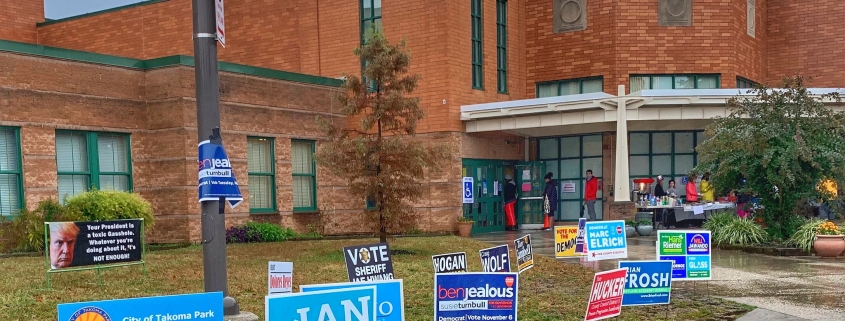On November 6, the 2018 midterm elections in the US have sparked public attention. Political analysts and journalists all over the world saw the elections as a great opportunity to assess Trump’s popularity during his two-year presidency.
Over the course of his service, many contradictions and speculations have emerged, favouring one-way or another the polarisation between the Democrat and Republican Party. So, why midterm elections are so important for US politics? To answer this question, it is important to analyse first the purpose of the Midterm elections.
What do we know about the Midterm elections?
In fact, the Congressional elections take place every mid-term of the president’s service; hence the name. On a federal level, Americans cast their vote for the election of all 435 seats in the House of Representatives and one-third of the Senate positions.
Of less importance and popularity compared to the presidential elections, the mid-term results can be used as a pilot for scoring the chances for the president’s re-election and the dynamic of the Republican/Democrat control over the Congress. On the next paragraph, the analysis focuses on the correlation between the Congressional elections and the president’s stay at the office.
How mid-term elections can affect the president’s decision making?
According to the United States Constitution, there are three distinguished powers of the Government: the Congress1, which is the legislate body responsible for making laws; the President with his Cabinet that represents the executive body for carrying out laws; the Supreme and Federal Courts incorporating the judicial power for interpreting the US laws.
Based on the above, the Congress is responsible for making the laws2 but also has the power to exert pressure on the president’s decision making. By representing the legislative body, it has the final say in the president’s proposed nominations for vital federal roles. Under special circumstances, Congress has the authority to remove a president from the office.
For these reasons, the election and composition of Congress will play a key role in the president’s decision making. During the Midterms, Democrats and Republicans fight for the control of each chamber of the Congress with an ultimate goal; to win the legislative votes before reaching the president’s desk. In other words, the dominance of the president’s party on Congress will strengthen his/her executive power by securing also an influencing role on the legislative process.
Taking a closer look at the results of 2018 Midterms
After establishing a better understanding of the role of the Congression, it is the time to proceed with the analysis of the 2018-midterm results that could help us also to decode any hidden messages to better understand the future political trends.
Based on the most recent results of the 2018 Midterms, Democrats are taking control of the House, while Republicans obtain a strong majority on the Senate. Decidedly, the Democrats were the winners of the midterm elections. By exceeding its expectations, the party regained lost territory but also entered into a new ground.
- The House of Representatives
On the announcement of the results, one of the biggest surprises was the shift of influence on the House of Representative; from the Republicans to the Democrats. Based on the current House seat allocation, Republicans obtain 240 seats out of the 435, while Democrats hold 195 seats. After the elections, the equilibrium has shifted with the Democrats expected to reach the 230 seats while Republicans might fall to the 198 seats.
This significant loss for the Republicans can be attributed to the ‘’anti-Trump’’ anger accumulated over the last two years and the retirement of a significant number of Republicans (FT, 2018). In addition to that, the entrance of young women in Congress might have hurt the chances of the white male Republican candidates.
For Democrats, one of their strongest points for this victory was the involvement of young educated women as candidates or voters. Not only this demographic group was well represented on their candidates’ list but also on their electoral base as voters.
- The Senate
In regards to the Senate, one-third of the Senators were subject to elections amounting to 35 seats with 26 seats belonging to Democrats and 9 to Republicans. Prior to the elections, Republicans were controlling the Senate by 51 seats. No big changes or surprises are anticipated, as analysts estimate that the 51-49 composition will remain at the same level.
What the results will mean for the future of US politics
The battle between Democrats and Republicans has just begun. For Donald Trump as a Republican president, the need to have a strong Republican presence on the Congress has failed. Instead, a strong Democrat presence at the House is likely to restrain his legislative agenda.
The accusations against Donald Trump have stirred up public anger. By calling Americans to turn their back to Trump’s administration, the main plan for Democrats was to win over the elections and gain a stronger voice on the Congress. Now, Democrats will be able to oversee and investigate Trump’s work and even block some of his decisions. Another possibility is to attempt removing the president from the office. Nonetheless, the chances are very low; this would require the vote of two-thirds of the senators blaming Trump for impeachment – a practice that has never been adopted so far.
Undoubtedly, the ultimate goal for Democrats is to reverse the results in the next 2020 elections. However, this operation will not be very easy. A lot of work and preparation is required so that Democrats keep the positive momentum of the recent elections. First of all, the Republicans are likely to blame their competitors for the financial slowdown projected for next year. At the moment, the US economy is at its peak growth thanks to the introduction of Trump’s $2tn tax cuts.
Secondly, the potential victory on the next 2020 election will depend on the selection of a suitable frontrunner that will stand opposite to Donald Trump. The candidate’s ability to rally the electorate to the Democrats’ cause will be critical for gaining the lost ground of the 2016 elections; one good example is the Midwestern working class that switched sides from blue to red during the 2018 Elections when Hilary Clinton was running for the presidential elections (Zurcher, 2018).
Photo: Craig James, America Votes, 2018 | 13/365 (2018). Source: (flickr.com) | (CC BY-NC 2.0)
Footnotes
[1] The Congress:
There are two chambers that constitute the Congress; the House of Representatives with 435 members is elected every two years during the mid-term and presidential election year; the US Senate with 100 senators -each serving a six-year term- is divided between three Classes. Contrary to the House of Representatives, the Senate elections run every two years depending on which Class has reached the end of its term.
[2] The Congress is responsible for making the laws:
When a bill (a draft law) passes by the House of Representatives, it will be presented then to the Senate to vote in favour or against the bill. In case of acceptance, then a two-chamber committee (of the Senate and the House) shall be convened for the final approval. Finally, the president will decide whether to sign or veto the enrolled bill.
Bibliography
BBC (2018) A really simple guide to the US mid-term elections, BBC News, 5th November, Available at: https://www.bbc.co.uk/news/resources/idt-c2d5bac7-3827-44d1-b5a0-8e6c637736b2 (Accessed 17th November 2018)
CCN (2018) National Results, 2018 Election Results, CNN politics, Live Election results, Available at: https://edition.cnn.com/election/2018/results/house (Accessed 17th November 2018)
Financial Times (2018) US midterm elections 2018 results, Available at: https://ig.ft.com/us-midterm-elections/ (Accessed 17th November 2018)
Luce E. (2018) Donald Trump now faces an almighty battle with Congress, Financial Times, 7th November, Available at: https://www.ft.com/content/10b51fb0-e1b2-11e8-8e70-5e22a430c1ad (Accessed 17th November 2018)
McCarthy T. (2018) What the midterms can teach the Democrats about winning in 2020, The Guardian, 16th November, Available at: https://www.theguardian.com/us-news/2018/nov/16/democrats-midterms-results-lessons-2020-presidential-election (Accessed 17th November 2018)
U.S. Government (2018) Midterm Congressional, State, and Local Elections, Voting and Elections, Available at: https://www.usa.gov/midterm-state-and-local-elections (Accessed 17th November 2018)
U.S. Government (2018) 3 Branches of the U.S. Government, About the U.S., Available at: https://www.usa.gov/branches-of-government (Accessed 17th November 2018)
U.S. House of Representatives, The Legislative Process, The house explained, Available at: https://www.house.gov/the-house-explained/the-legislative-process (Accessed 17th November 2018)
U.S. Senate, The Senate and the United States Constitution, Chapter 3: Senate Classes, Available at: https://www.senate.gov/artandhistory/history/common/briefing/Constitution_Senate.htm#3 (Accessed 17th November 2018)
Zurcher A. (2018) Mid-term election results: The lessons US Democrats can learn for 2020, BBC News, 8th November, Available at: https://www.bbc.co.uk/news/world-us-canada-46120582 (Accessed 17th November 2018)






Leave a Reply
Want to join the discussion?Feel free to contribute!